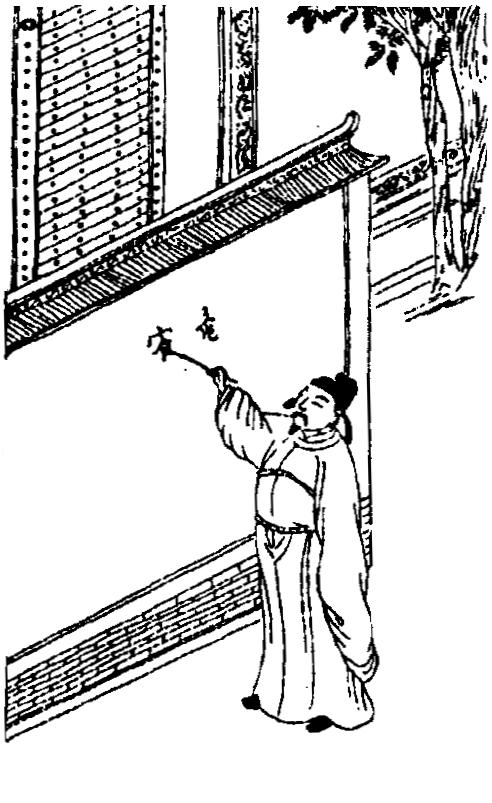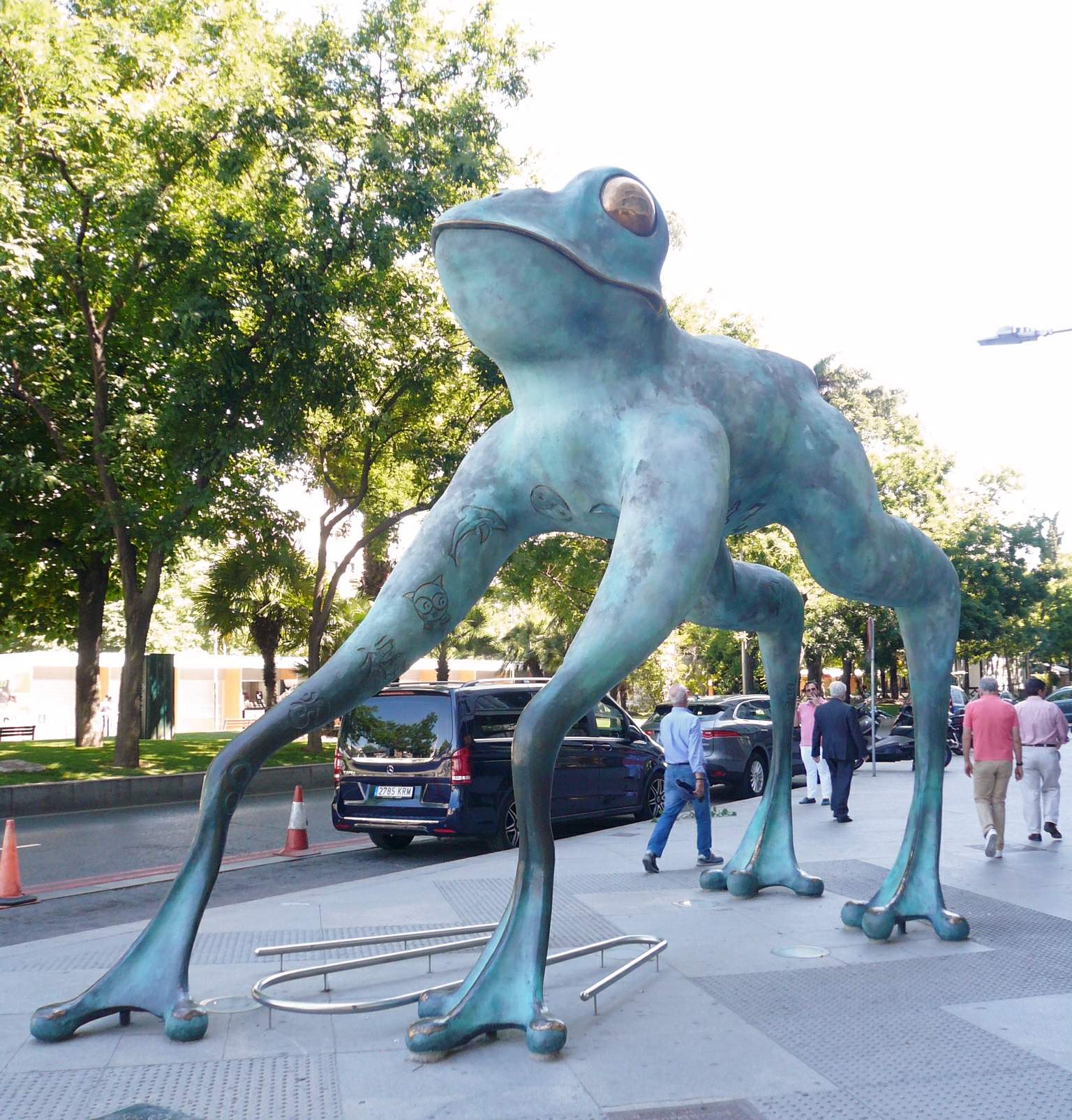|
Jin Chan
The Jin Chan (), also called Chan Chuy () or "Zhaocai Chan Chu" (), is most commonly translated as "Money Toad" or "Money Frog". It represents a popular feng shui charm for prosperity. This mythical creature is said to appear during the full moon, near houses or businesses that will soon receive good news (most of the time, the nature of this good news is understood to be wealth-related). The Jin Chan is usually depicted as a bullfrog with red eyes, flared nostrils and only one hind leg (for a total of three legs), sitting on a pile of traditional Chinese cash, with a coin in its mouth. On its back, it often displays seven diamond spots. According to feng shui beliefs, Jin Chan helps attract and protect wealth, and guards against bad luck. Because it symbolizes the flow of money, feng shui lore insists that a Jin Chan statue should not be positioned facing the main door ("outward"). It also "should never be kept in the bathroom, bedroom, dining room or kitchen". The Jin Chan i ... [...More Info...] [...Related Items...] OR: [Wikipedia] [Google] [Baidu] |
Chinese Edible Frog
The Chinese edible frog, East Asian bullfrog, or Taiwanese frog (''Hoplobatrachus rugulosus'') is a species of frog in the family Dicroglossidae. It is found in Cambodia, China, Hong Kong, Laos, Macau, Malaysia, Myanmar, the Philippines, Taiwan, Thailand, and Vietnam. Its natural habitats are freshwater marshes, intermittent freshwater marshes, arable land, pasture land, rural gardens, urban areas, ponds, aquaculture ponds, open excavations, irrigated land, seasonally flooded agricultural land, and canals and ditches. They breed in spring to early summer. The domesticated Thai variety and wild Chinese populations of ''H. rugulosus'' belong to two separate genetic lineages respectively.Yu D, Zhang J, Li P, Zheng R, Shao C (2015) Do Cryptic Species Exist in Hoplobatrachus rugulosus? An Examination Using Four Nuclear Genes, the Cyt b Gene and the Complete MT Genome. PLoS ONE 10(4): e0124825. doi:10.1371/journal.pone.0124825 Yu et al. (2015) suggest that ''H. rugulosus'' may in fac ... [...More Info...] [...Related Items...] OR: [Wikipedia] [Google] [Baidu] |
Cash (Chinese Coin)
The cash or qian was a type of coin of China and East Asia, used from the 4th century BC until the 20th century AD, characterised by their round outer shape and a square center hole (方穿, ''fāng chuān''). Originally cast during the Warring States period, these coins continued to be used for the entirety of Imperial China. The last Chinese cash coins were cast in the first year of the Republic of China. Generally most cash coins were made from copper or bronze alloys, with iron, lead, and zinc coins occasionally used less often throughout Chinese history. Rare silver and gold cash coins were also produced. During most of their production, cash coins were cast, but during the late Qing dynasty, machine-struck cash coins began to be made. As the cash coins produced over Chinese history were similar, thousand year old cash coins produced during the Northern Song dynasty continued to circulate as valid currency well into the early twentieth century. In the modern era, these ... [...More Info...] [...Related Items...] OR: [Wikipedia] [Google] [Baidu] |
Han Chinese
The Han Chinese () or Han people (), are an East Asian ethnic group native to China. They constitute the world's largest ethnic group, making up about 18% of the global population and consisting of various subgroups speaking distinctive varieties of the Chinese language. The estimated 1.4 billion Han Chinese people, worldwide, are primarily concentrated in the People's Republic of China (including Mainland China, Hong Kong and Macau) where they make up about 92% of the total population. In the Republic of China (Taiwan), they make up about 97% of the population. People of Han Chinese descent also make up around 75% of the total population of Singapore. Originating from Northern China, the Han Chinese trace their cultural ancestry to the Huaxia, the confederation of agricultural tribes living along the Yellow River. This collective Neolithic confederation included agricultural tribes Hua and Xia, hence the name. They settled along the Central Plains around the middle a ... [...More Info...] [...Related Items...] OR: [Wikipedia] [Google] [Baidu] |
Taoism
Taoism (, ) or Daoism () refers to either a school of philosophical thought (道家; ''daojia'') or to a religion (道教; ''daojiao''), both of which share ideas and concepts of Chinese origin and emphasize living in harmony with the '' Tao'' (, 'Thoroughfare'); the ''Tao'' is generally defined as the source of everything and the ultimate principle underlying reality. The '' Tao Te Ching'', a book containing teachings attributed to Laozi (), together with the later writings of Zhuangzi, are both widely considered the keystone works of Taoism. Taoism teaches about the various disciplines for achieving perfection through self-cultivation. This can be done through the use of Taoist techniques and by becoming one with the unplanned rhythms of the all, called "the way" or "Tao". Taoist ethics vary depending on the particular school, but in general tend to emphasize ''wu wei'' (action without intention), naturalness, simplicity, spontaneity and the Three Treasures: , compassio ... [...More Info...] [...Related Items...] OR: [Wikipedia] [Google] [Baidu] |
Liu Haichan
Liu Haichan was a ( 10th century) Daoist '' xian'' ("transcendent; immortal") who was a patriarch of the Quanzhen School, and a master of ''neidan'' "internal alchemy" techniques. Liu Haichan is associated with other Daoist transcendents, especially Zhongli Quan and Lü Dongbin, two of the Eight Immortals. Traditional Chinese and Japanese art frequently represents Liu with a string of square-holed cash coins and a mythical three-legged ''chanchu'' (; "toad; toad in the moon"). In the present day, it is called the '' Jin Chan'' (), literally meaning "Money Toad", and Liu Haichan is considered an embodiment of Caishen, the God of Wealth. Names Liu Haichan is known by many names. Liu 劉 is a common Chinese family name, notably for the Han dynasty imperial family. Haichan combines ''hǎi'' 海 "sea; ocean; huge group (of people/things)" and ''chán'' 蟾 "toad", used in the compound ''chánchú'' 蟾蜍 (蟾諸 or 詹諸) "toad; fabled toad in the moon". One source, the (ear ... [...More Info...] [...Related Items...] OR: [Wikipedia] [Google] [Baidu] |
Xian (Taoism)
''Xian'' () refers to a person or similar entity having a long life or being immortal. The concept of ''xian'' has different implications dependent upon the specific context: philosophical, religious, mythological, or other symbolic or cultural occurrence. The Chinese word ''xian'' is translatable into English as: * (''in Daoist philosophy and cosmology'') spiritually immortal; transcendent human; celestial being * (''in Daoist religion and pantheon'') physically immortal; immortal person; an immortal; saint * (''in Chinese alchemy'') alchemist; one who seeks the elixir of life; one who practices longevity techniques ** (''or by extension'') alchemical, dietary, or qigong methods for attaining immortality * (''in Chinese mythology'') wizard; magician; shaman; sorcerer * (''in popular Chinese literature'') genie; elf, fairy; nymph; (''xian jing'' is fairyland, faery) * (''based on the folk etymology for the character , a compound of the characters for ''person'' and ''mounta ... [...More Info...] [...Related Items...] OR: [Wikipedia] [Google] [Baidu] |
Maneki Neko
The ''maneki-neko'' (招き猫, ) is a common Japanese figurine which is often believed to bring good luck to the owner. In modern times, they are usually made of ceramic or plastic. The figurine depicts a cat, traditionally a calico Japanese Bobtail, with a paw raised in a Japanese beckoning gesture. The figurines are often displayed in shops, restaurants, pachinko parlors, dry cleaners, laundromats, bars, casinos, hotels, nightclubs, and other businesses, generally near the entrance. Some ''maneki-neko'' are equipped with a mechanical paw which slowly moves back and forth. ''Maneki-neko'' come in different colors and styles and vary in degrees of detail. Common colors are white, black, red, and gold. In addition to statues, ''maneki-neko'' can be found in the form of keychains, piggy banks, air fresheners, pots, and numerous other media. ''Maneki-neko'' are sometimes referred to simply as "lucky cats". Common features ''Maneki-neko'' are traditionally depicted seated, holding ... [...More Info...] [...Related Items...] OR: [Wikipedia] [Google] [Baidu] |
Nang Kwak
Nang Kwak ( th, นางกวัก) is a spirit or household divinity of Thai folklore. She is deemed to bring good fortune, prosperity, attract customers to a business, and found among merchants. Commonly dressed in red Thai style clothing, Nang Kwak is an incarnation of Mae Po Sop, the Thai rice goddess. She is a version of the Hindu goddess Lakshmi. Iconography Nang Kwak is represented as a beautiful woman wearing a red dress (not always, but more often than other colors) fashioned in the Thai style. She also wears a golden crown on her head and is in the sitting or kneeling position. Her right hand is raised in the Thai way of beckoning a customer, with the palm of the hand curved and pointing downwards. Her left hand is resting on her side or holds a bag full of gold near her lap. The present iconographic figure of Nang Kwak is an incarnation of Mae Po Sop (แม่โพสพ), the Siamese rice goddess. However, unlike Mae Po Sop, Nang Kwak does not wear the harveste ... [...More Info...] [...Related Items...] OR: [Wikipedia] [Google] [Baidu] |
Lucky Frog
''Lucky Frog'' ( es, Rana de la fortuna) is a bronze sculpture by the Spanish artist dEmo, installed in Madrid, Spain, in 2014, outside the Casino Gran Madrid on the Paseo de Recoletos. The sculpture is tall and weighs . The work was commissioned for the opening of the casino, and was a gesture of thanks to the city for restoring legal gambling after 90 years. It was unveiled on 3 April 2014 by journalist Carme Chaparro and actor Paco León. The frog is a sign of good fortune in Feng shui and its underbelly is engraved with symbols of good luck from world cultures. The 34 symbols include several numbers as well as pictures including a scarab artifact, a four-leaf clover, the peace sign and various currency symbols and religious signs. The patina, the protective coating on the metal, was applied by specialist Juan Manuel González. Its turquoise green is also considered lucky. The sculpture is located near to Fernando Botero's ''Woman with Mirror ''Woman with Mirror'' ( e ... [...More Info...] [...Related Items...] OR: [Wikipedia] [Google] [Baidu] |
Lucky Symbols
A good luck charm is an amulet or other item that is believed to bring good luck. Almost any object can be used as a charm. Coins and buttons are examples, as are small objects given as gifts, due to the favorable associations they make. Many souvenir shops have a range of tiny items that may be used as good luck charms. Good luck charms are often worn on the body, but not necessarily. History The Mojo is a charm originating in African culture. It is used in voodoo ceremonies to carry several lucky objects or spells and intended to cause a specific effect. The concept is that particular objects placed in the bag and charged will create a supernatural effect for the bearer. Even today, mojo bags are still used. Europe also contributed to the concept of lucky charms. Adherents of St. Patrick (the patron saint of Ireland), adopted the four-leaf clover as a symbol of Irish luck because clovers are abundant in the hills of Ireland. List Luck is symbolized by a wide array of objec ... [...More Info...] [...Related Items...] OR: [Wikipedia] [Google] [Baidu] |






